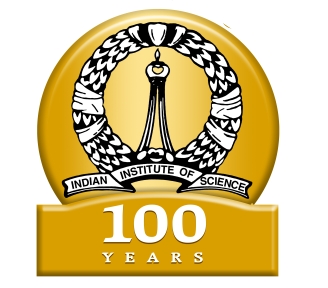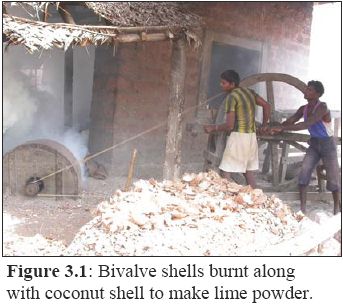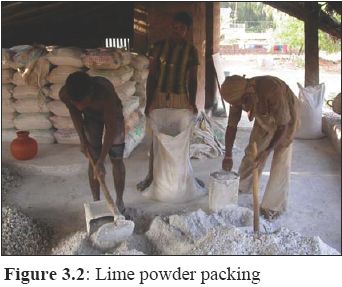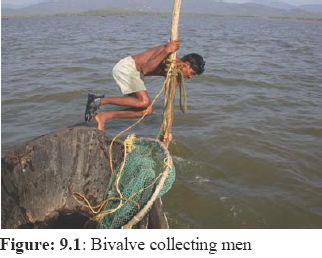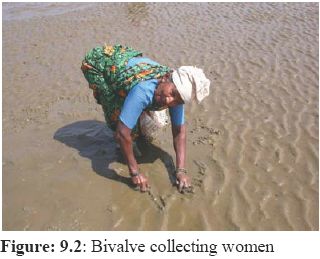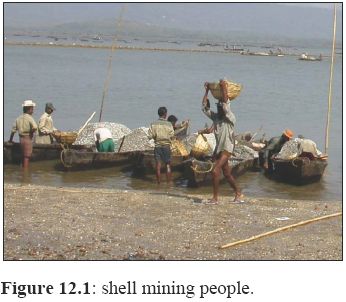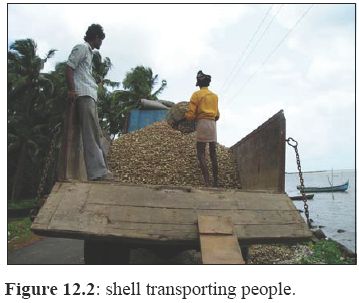
|
Summary
Estuaries provide valuable resources like fishes, bivalves, crabs, shrimps, etc. Thus, it
plays a pivotal role in rural livelihood and constitute as an important socio-economic
entity. Mangrove vegetation, ranking high in productivity, is often associated with
tropical and sub-tropical estuaries. Biological productivity in estuaries depend on
fresh water ecosystem and hence its terrestrial ecosystems. Estuaries being inter-tidal
zones form a vital interface between marine and terrestrial environments. These semienclosed
bodies of coastal water have a free connection with the open sea and within
which seawater is measurably diluted with fresh water of terrestrial origin, forms a
highly productive, dynamic and unique ecosystem providing food, transport,
recreation, etc.
A study was undertaken focusing on bivalves of the Aghanashini river estuary of
South Indian west coast, in an effort to document the edible bivalve diversity and the
often neglected socio-economic life based on it. Estimates have been made of people
involved in bivalve collection and trade, quantity and species collected and the overall
role of bivalves in sustaining a rural economy. Bivalves harvested are Paphia
malabarica, Katelysia opima and Meretrix meretrix, M. casta and Crassostrea sp.
The estuary provides diverse kinds of habitats (in terms of water depth, salinity, soil
nature and rockiness) for different bivalve species. Harvests are higher during postmonsoon
(November-May) compared to monsoon (June-October). The bivalve-based
economy has an estimated turnover of Rs. 57.8 million per year. It generates direct
employment for about 2,347 people, and nutritional security of millions more along
the Karnataka coast and also in neighbouring states. This study was undertaken at a
time when an ultra-thermal plant was to be set up in this estuarine base inconsiderate
of its ecology and economics.
Keywords : Biodiversity, Bivalves, Estuary, Economic valuation, Hotspots, Molluscs,
Western Ghats
|
Introduction
India has a coastline of 7,516 km (http://india.gov.in/sectors/defence2.php), adjoining
the continental regions and the offshore islands and a very wide range of coastal
ecosystems such as estuaries, lagoons, mangroves, backwaters, salt marsh, rocky
coast, sand stretches and coral reefs, which are unique biotic and abiotic properties
and process (Venkataraman and Wafer, 2005). This study attempts to quantify the
ecosystem goods and services provided by bivalve mollusks in the Aghanashini
estuary of west coast of Karnataka State, India. Estuaries play a pivotal role in rural
livelihood by providing valuable resources like fishes, molluscs, crabs, prawns,
shrimps, etc. and thus constitute an important socio-economic entity. They are highly
productive, dynamic and unique ecosystem providing food, transport, recreation, etc.
Mangroves, one of the unique ecosystems, high ranking in productivity, are often
associated with tropical and sub-tropical estuaries. These are semi-enclosed coastal
body of water, which has a free connection with the open sea, and within which
seawater is measurably diluted with fresh water derived from land drainage
(Pritchard, 1967). The Karnataka coastal region, which extends between the Western
Ghats edge of the Karnataka Plateau in the east and the Arabian Sea in the West,
covers of Uttara Kannada, Udupi, and Mangalore districts, which encompass number
of estuaries along the 267 km (http://www.karnataka.com/profile/physiography.html)
coastal line. The Uttara Kannada district located in central Western Ghats comprises
four estuaries namely Kali (Sadashivagad), Bedthi (Gangavali), Aghanashini (Tadri)
and Sharavathi (Gersoppa/Banaganga).
The Western Ghats in India is one among the 34 biodiversity hotspots of the world
(http://www.biodiversityhotspots.org/) is a chain of mountains, stretching north-south
along the western peninsular India for about 1,600 km, harbours rich flora and fauna.
Various forest types such as tropical evergreen, semi-evergreen, moist and dry
deciduous and high altitude sholas mingle with natural and manmade grasslands,
savannas and scrub, in addition to, agriculture, plantation crops, tree monocultures,
river valley projects, mining areas and many other land-uses. Over 4,000 species of
flowering plants (38% endemics), 330 butterflies (11% endemics), 156 reptiles (62%
endemics), 508 birds (4% endemics), 120 mammals (12% endemics) 289 fishes (41%
endemics) and 135 amphibians (75% endemics) (Daniels, 2003; Babu and Nayar,
2004; Dahanukar et al., 2004; Gururaja, 2004) are among the known biodiversity of
the Western Ghats. This rich biodiversity coupled with higher endemism could be
attributed to the humid tropical climate, topographical and geological characteristics,
and geographical isolation (Arabian Sea to the west and the semiarid Deccan Plateau
to the east). The four major rivers (Kali, Bedthi, Aghanashini and Sharavathi) of
Uttara Kannada district of Karnataka together account for 92 fish species (Bhat,
2003).
Recently, the government proposed to set up a coal (fossil fuel) based 4,000 MW
Ultra Mega Power Plant in the estuarine complex of Aghanashini River. Burning of
fossil fuels in the Power Plant will leave the flying ashes, increase the temperature of
water body by leaving hot water, would likely be pollute the environment and is
detrimental to the sustenance of ecologically sensitive Western Ghats. This study,
under taken at the time when such a major threat was looming large over this
productive but fragile estuarine complex, highlights the need for restrain while
locating major developmental projects which could be detrimental to precious
ecosystems and scores of livelihoods dependent on them.
Molluscs
The name Mollusc (=Mollusk) was derived from Latin mollus meaning soft. They
belong to the Phylum Mollusca. The first Mollusc appeared as far back as the
Cambrian period, approximately 500 million years ago. They are the second largest
phylum among the invertebrates comprising more than 100,000 species. In India, till
today, 5070 species of Mollusca have been recorded of which, 3370 species are from
marine environment (Venkataraman and Wafer, 2005), while rest from the freshwater
and terrestrial environment. They have been exploited worldwide for food,
ornamentation and pearls throughout human history. Geologic evidence from South
Africa indicates that systematic human exploitation of marine resources started about
70,000 to 60,000 years ago (Volman, 1978).
In Molluscs, Lamellibranchia (Pelecypoda or Bivalvia), Gastropoda and Cephalopoda
are the only classes fished. The utilization of gastropods for food is very limited, and
a few important species occasionally collected for this purpose. In India, Molluscs
fishery comprise mainly by bivalves such as clams, mussels and oysters. Except for
the chank and pearl-oyster beds, the most productive of which are concentrated on the
south eastern coast, the shell-fish resources of other commercial species of molluscs
are generally more plentiful on the west coast (CSIR, 1962b).
LAMELLIBRANCHIA (PELECYPODA OR BIVALVIA) |
TOP |
Bivalves are the second largest Class in the Phylum Mollusca. It has two shells or
valves join together with the help of teeth like structure called hinge and fibrous tissue
- ligament (Figure 1). The shells are made up of calcium carbonate.
Most of the forms are completely sedentary remaining attached to hard substrata
(Figure 2) by thread-like byssus of the foot or by one of their shell valves. A few
forms burrow into submerged timbers, and commensal and parasitic types are also
known. Some marine forms extended to a depth of 4.94 km. Life histories of bivalves
pass through larval stages, which undergo remarkable changes before attain adult
characteristics. Most commonly utilized bivalves for food include clams (Veneridae),
sea-mussels (Mytilidae) and edible oysters (Ostreidae) (CSIR, 1962a).

Globally, commercial exploitation of bivalves for food is dominated by epifaunal taxa
such as ostreids, mytilids and pectinids. Annual harvests of bivalves for human
consumption represent about 5% by weight of the total world harvest of aquatic
resources (Roberts, 1999). In India eight species of oysters, two species of mussels,
17 species of clams, six species of oysters, four species of giant clams, one species of
window-pane oyster are exploited extensively from marine regions. However, the
Molluscan fishery is not well organized along the Indian coast. They are exploited in
large quantities by traditional methods and sold live and dried conditions in the
market for human consumption (Venkataraman and Wafer, 2005; Chatterji, 2002).
Rushikulya estuary, Orissa has 317 species of molluscs (Ghosh, 1992). 34 of 70 creeks of Maharashtra support clam fishery (Mane, 1973) and clam fishery in
Maharashtra is mainly dependent on M. meretrix, Katelysia opima and Paphia
laterisules (Ranade, 1964). Molluscs especially clams, are abundant in South Kanara
district, Karnataka and are harvested by traditional methods during non monsoon
period (James et al., 1975; Chatterji et al. 2002). The CMFRI (Central Marine
Fisheries Research Institute) estimate shows of increasing trend with 4,583 t of
bivalves (in 2006), compared to 905 t (in 1997). Total molluscs collection in
Karnataka shows similar trend with 16,225 t (in 2006) and 239 t in 1985
(http://www.cmfri.com/html/cmfriDATA01.html). Table 1 lists some edible species of
bivalves in India (CSIR, 1962a; CSIR, 1962b). The bivalves are rich in nutrients,
particularly proteins, fats and minerals (CSIR 1962a). The Indian edible bivalves have
protein (5-14%), fats (0.5-3%), calcium (0.04-1.84%), phosphorus (0.1-0.2%) and
iron (1-29 mg/100 g of the fresh weight). Chemical composition of a few important
edible Indian Bivalves (CSIR, 1962a; Nagabhushanam and Thompson, 1997) are
given in Table 2.
The role of small-scale fisheries and how they fit into the rural economy remains
poorly understood. Unlike large-scale industrial fisheries, they receive little attention
from policy-makers. Globally, this kind of informal small-scale fisheries and
fisheries-related activities (processing, trading, etc.) make an important contribution
to the nutrition, food security, sustainable livelihoods and poverty alleviation of many,
especially developing countries (Staples et al., 2004).
This study focuses on intertidal shellfishery, especially bivalve gathering – a informal
small-scale fishery in the Aghanashini River estuary situated towards the center of
south Indian west coast, in the State of Karnataka. Bivalve gathering has been a
tradition among the inhabitants for centuries, and it is still being practiced. Harvesting
is done manually during low tides. The collectors may wade through shallow waters
or use small boats to collect in deeper water. The targeted bivalve speceis are Clams
P. malabarica, K. opima, Meretrix sp., and V. cyprinoides, Mussel P. viridis, and
Oysters Crassostrea sp. The harvesters sell the bivalves to traders who come to the
collection area or sell to the local consumers by house to house sale or in the local
markets.
Typically, harvesting is carried out in the 19 coastal villages by Harikanthra and
Ambiga fishing communities as well as by Halakkivokkals, Namdharis, and
Gramvokkals (basically farming communities). Both men and women are involved in
the harvest and about 2370 people were dependent on bivalve fisheries, for
employment. This study will provide an insight to policy and decision makers in
understanding the role of small-scale fishery and its sustainable livelihood value and enable them to conserve such neglected, nevertheless ecologically and economically
important, habitats for posterity.

Clams are considered to be nutritious and delicious and are fished in considerable
quantities in some coastal places. Clams and other bivalves of their kind are usually
handpicked in shallow waters at low tides.
Indian waters have two species of large size mussels; they are the brown mussel,
Perna indica and the green mussel, Perna viridis Linn, belonging to Mytilidae family
usually grow over submerged rocks where they attached themselves by means of their
slimy thread like structures called byssus. The brown mussel, Perna sp., is restricted
in its distribution from south of Quilon to Cape Comorin on the west coast and up to
Tirunelveli dist. on the east coast. The green mussel, Perna viridis Linn. is abundant
at Cochin, Malabar and north of Kerala and distributed on both the coasts. In
Bombay, Ratnagiri and Karwar it is reported to be rare. The green mussel occurs not
only in the coastal waters, but also in the brackwaters. The bearded weaving mussel,
Modiolus barbatus (Linn.), occurring in great abundance in the Palk Bay and pearl
bank region of the Gulf of Mannar, is also used as food (CSIR, 1962a;
Nagabhushanam and Thompson, 1997). Oysters are inhabited where brackish water is
renewed by tidal flow and the substratum is suitable for their attachment. The
backwater oyster, Crassostera madrasensis (Peterson), is commonly found to be
confined to the southern regions on the west coast but widely distributed in all
estuaries and backwaters of the east coast, the rock oyster, C. cucullata (Born), from
the intertidal rocky coast, of Bombay and Karwar, the disc oyster C. discoidea
(Gould), from the littoral zone of the coastal areas and C. gryphoides (Newton &
Smith) found in the muddy creeks, of Kutch, Dwarka, Bombay, Ratnagiri, Jaytapur,
Karwar, etc. on the west coast, all belonging to the family Ostreidae of the class
Bivalvia (CSIR, 1962a).

Economic Importance of BIVALVES
Bivalves have been exploited worldwide for food, ornamentation and pearls
throughout human history. Economic importances of bivalves are:
- Fish bait : Molluscs like cuttlefish, squids, octopods and fingered chank
shells are used as efficient bait in fishing. Mussels, clams, and gastropods
are also often used as fish bait (CSIR, 1962a).
- Medicinal uses : A number of species of Molluscan soft bodies and their
shells are used in the treatment of various diseases and preparation of
medicines and medicinal oils. Some of the medicinally useful species and
their treatment in different diseases are listed in the following table 3
(CSIR, 1962a).
- Ornaments and Jewellery : The pearl oysters and other molluscan shells
fished for decorative and ornamental purposes are of considerable
commercial importance in Madagascar, Western Australia, Philippines,
Japan and Ceylon. In India, pearl fisheries and chank fisheries have been
exploited from ancient times. Among bivalves the shell of the
windowpane oyster, Placuna placenta, is used for glazing windows and
verandah roofs. The common freshwater mussel, Lamellidens marginalis,
produces pearls of fair quality in large numbers; they are collected and
sold in South India. Pearls of poor lustre are also reported from the green
mussel, Perna viridis, from Sonapur backwaters (CSIR, 1962a;
Nagabhushanam and Thompson, 1997).
- Pearl fisheries : Pearls of high value are obtained from pearl-oysters of
the genus Pinctada Roding (class Bivalvia, family Pteriidae), of which
several species, viz. P. vulgaris (Schumacher), P. chemnitzi (Philippi), P.
margaritifera (Linn.), P. anomioides (Reeve), and P. atropurpurea
(Dunker), occur in Indian waters. Of these P. vulgaris is by far the
commonest and the most important and is widely distributed in the Gulf
of Kutch, Gulf of Mannar and the Palk Bay (CSIR, 1962b).
- Shells : The calcium rich bivalve shells are mainly used for lime making
and poultry feeds. The lime is used for white-washing and for chewing
with betel pan. Lime is used neutralizing acidic agricultural soils (CSIR,
1962a).
- Lime manufacture : The production of lime from molluscan shells
(Figure 3.1 and figure 3.2) is important industry in the coastal areas of
India. Shells of various species of gastropod and more especially
bivalves are gathered in large quantities from the estuaries and
backwaters. Lime produced by burning molluscan shells is of superior
quality for use in masonry construction and white washing. It is used also
as a fertilizer, prawn feed and poultry feed. The shells are directly used
for the production of high grade cement (CSIR, 1962a).The commonly
used bivalve species for lime manufacture in the Aghanashini estuarine
region are the Paphia malabarica, Meretrix meretrix, M. casta, Katelysia
opima and Vellorita cyprinoids. The death shells of these bivalves are
mixed with charcoal or outer coat of coconut then the mixture burn in to
powder. Burning process may continue for one to two hours depends
upon the amount of material kept for the lime making process.
- Miscellaneous : The shells, of the Placuna Bruguiere, Spirula Lam., and
of cockles (Chiefly Cardiidae), are used in the manufacture of tooth
pastes. The shells are collected in Tuticorin and sent to Calcutta and
Madras for this purpose (CSIR, 1962a).
Harmful molluscs
Marine borers belonging to the families Pholadidae and Teredinidae of Bivalvia
cause substantial damage to underwater wooden construction, wooden sailing craft and floating timber, particularly in the tropics. The sea fishing industry which depends
mainly on wooden catamarans and boats is reported to suffer an annual loss of about a
crore of rupees as a result of borer damage.
Martesia striata Linn is a common burrowing pholad mollusc can bore into floating
wood up to a depth of 17 m. in the sea. Several species of teredinids of shipworms
belonging to the genera Teredo Linn. and Bankia Gray are particularly destructive. A
few important among them are: Teredo manni (Wright), T. diedrichseni Roch, Bankia
carinata Leach and B. companuellata Moll. Some species of the genus Teredo burrow
in the wood when it is tiny and continue to live in the burrow. Some species would
attain a length of 1 m or more, with a diameter of c. 6.3 mm (CSIR, 1962a).
Morphology of BIVALVES |
TOP |
Figure 4 illustrates the typical morphology of bivalves. Some of the general features are :
- SHELL : The bivalve shell acts as a skeleton to protect against predators, and
in burrowing species it helps to keep mud and sand out of the mantle cavity.
Its main component is calcium carbonate and is formed by the deposition of
crystals of this salt in an organic matrix of the protein, conchiolin. Calcium
for shell growth is obtained from the diet, or taken up from seawater. The
colour, shape and markings on the shell vary considerably between the
different groups of bivalves (Gosling, 2003).
- Shell Formation : The shell is secreted by the mantle. The calcium ions
excreted from the blood mix with the fluid present in the mantle cavity,
forming calcium carbonate. The calcium carbonate is absorbed by
“conchiolin”, a secretion of the mantle. The conchiolin crystallises into
various forms, of which calcite and argonite forms are utilised in shell
formation (Apte, 1998).
- MANTLE : In bivalves the mantle consists of two lobes of tissue which
completely enclose the animal within the shell. Between the mantle and the
internal organs is a capacious mantle cavity. Cilia on the inner surface of the
mantle play an important role in directing particles onto the gills and in
deflecting heavier material along rejection tracts towards the inhalant opening
(Gosling, 2003).
- GILLS : The lamellibranch gills, or ctenidia, are two large, curtain-like
structures that are suspended from the ctenidial axis that is fused along the
dorsal margin of the mantle. Generally, the gills follow the curvature of the
shell margin with the maximum possible surface exposed to the inhalant
water flow. Cilia on the gill filaments have specific arrangements and
functions. They are responsible for drawing water into the mantle cavity and
passing it through the gill filaments, and then upwards to the exhalant
chamber and onwards to the exhalant opening. In bivalves the gills have a
respiratory as well as a feeding role. Their large surface area and rich
haemolymph supply make them well suited for gas exchange (Gosling, 2003).
- STOMACH : The mouth is ciliated and leads into a narrow ciliated
oesophagus. Ciliary movement helps to propel material towards the stomach.
Indeed, this method of moving material is found throughout the length of the
alimentary canal, primarily because it lacks a muscular wall. The stomach is
large and ovalshaped and lies completely embedded in the digestive gland,
which opens into it by several ducts (Gosling, 2003).The digestive gland,
which is brown or black and consists of blind-ending tubules that connect to
the stomach by several ciliated ducts, is the major site of intracellular
digestion. Within these ducts there is a continuous two-way flow: materials
enter the gland for intracellular digestion and absorption and wastes leave en
route to the stomach and intestine. Rejected particles from the stomach as
well as waste material from the digestive gland pass into the long coiled
intestine. The waste is formed into faecal pellets that are voided through the
anus and are swept away through the exhalant opening (Gosling, 2003).
- FOOT : The primitive mollusc had a broad ciliated flat foot, well supplied
with mucous gland cells, and the animal is believed to have moved over the
lubricated substrate in a gliding motion, using a combination of ciliary action
and muscular contractions. In the evolution of bivalves the body became
laterally compressed. Consequently, the foot lost its flat creeping sole and
became blade-like and directed in an anterior direction as an adaptation for
burrowing. Bivalves use the foot for locomotion and burrow in to substrate
(Gosling, 2003).
- GONADS : The reproductive system in bivalves is exceedingly simple. The
gonads are paired and each gonad is little more than a system of branching
tubules, and gametes are budded off the epithelial lining of these tubules. The
tubules unite to form ducts that lead into larger ducts and eventually terminate
in a short gonoduct (ibid). In primitive bivalves, e.g. the nut shell, Nucula, the
gonoducts open into the kidneys, and eggs and sperm exit through the kidney
opening (nephridiopore) into the mantle cavity. In most bivalves the
gonoducts open through independent pores into the mantle cavity, close to the
nephridiopore. With the exception of oysters (Ostrea sp.), fertilisation is
external and the gametes are shed through the exhalant opening (Gosling,
2003).
- HEART : The heart lies in the mid-dorsal region of the body, close to the
hinge line of the shell. It lies in a space called the pericardium, which
surrounds the heart dorsally and a portion of the intestine ventrally. The heart
consists of a single, muscular ventricle and two thin-walled auricles. The
circulatory system is an open system with the haemolymph in the sinuses
bathing the tissues directly. From the sinuses the haemolymph is carried to
the kidneys for purification (Gosling, 2003).
- EXCRETORY ORGANS : There are two types of excretory organs in
bivalves, the pericardial glands and the paired kidneys (in Mytilus U-shaped).
The brown-coloured pericardial glands, sometimes referred to as Keber’s
organs, develop from the epithelial lining of the pericardium and come to lie
over the auricular walls of the heart. Waste accumulates in certain cells of the
pericardial glands and this is periodically discharged into the pericardial
cavity and from there it is eliminated via the kidneys (Gosling, 2003).
- NERVES : The nervous system of bivalves is fundamentally simple. It is
bilaterally symmetrical and consists of three pairs of ganglia and several pairs
of nerves. The cerebral ganglia innervate the palps, anterior adductor muscle,
and part of the mantle, as well as the statotocysts and osphradia. The pedal
ganglia control the foot. The visceral ganglia control a large area: gills, heart,
pericardium, kidney, digestive tract, gonad, posterior adductor muscle, part or
the entire mantle, siphons and pallial sense organs (Gosling, 2003).

Economic Valuation
Economic valuation is a tool to aid and improve wise use and management of natural
resources by providing a means for measuring and comparing the various benefits of
resources. The resources are quantified based on the goods and services made
possible by ecosystem’s functions. The economic worth of goods or services,
generally measured in terms of what individuals are willing to pay for. The value of
the benefit is determined by its price, i.e., the amount of money for which it will be
exchanged. The value of a benefit is the price of that product in the open market and
the worth of that benefit to a potential buyer. This is measured in economic terms as
willingness to pay. In other words, the economic value of the ecosystem
services/commodity is measured by people's willingness to pay (WTP) for those
benefits (http://wgbis.ces.iisc.ac.in/energy/water/paper/ecodoc2004.htm).
Economic valuation is an effective method to understand the significance of
ecosystem goods or services provide by nature. The strength of the economic
valuation methods is that their concept of value incorporates the relationship between
humankind and ecosystem products (Winkler, 2006).
Objective
The study will provide a substantive basis to the planners to have a re-look at the
estuary. These ecosystems have been under constant threat due to lack of knowledge
of the benefits derived from these ecosystems and a more importantly lack of holistic
approaches in the implementation of developmental projects. Locating major projects
in an ecologically sensitive regions rather demonstrates lack of understanding of
ecosystem functioning and also services and goods on the part of regional decision
makers.
Objectives of this endeavour were :
i) to document the diversity of bivalves and
ii) to
describe the benefits derived from them by harvesters and others who are associated
with processing and trade.
This involved :
- Inventorisation and mapping of the edible bivalve species of Aghanashini
estuary
- Estimation of the number of people associated with bivalve collection and
trade
- Methods and techniques of bivalve harvesting and
- Quanitification of benefits derived from bivalves: economic valuation of
bivalves
Materials and Methods |
TOP |
Study Area :
The Aghanashini or Tadri River (total length 121 km) originates in the Sirsi taluk of
Uttara Kannada district in the central Western Ghats of Karnataka State. Winding its
way through deep gorges and valleys the river meets the tides of the Arabian Sea and
forms a large estuarine expanse (13 km long and 2 to 6 km wide) in the coastal taluk
of Kumta. The estuary has its outlet into the sea in between the villages of
Aghanashini in the south and Tadri in the north. The study area lies between the lat
14.391° to 14.585° N and long. 74.304° to 74.516° E. Situated in the estuarine
complex of the river are about 25 villages of which people from 19 villages
traditionally are associated with bivalve harvesting (Figure 5).
Methods
The survey (both household and field) was undertaken during June 2006 to March
2007. Diversity and distribution of edible bivalve species, was documented by field
observations. Bivalve harvesting villages were identified by interviewing people
living closer to Aghanashini estuary. In the bivalve collecting villages, household
surveys were undertaken using questionnaires. Within the identified villages we
located the hamlets of communities which have bivalve collection as major activity.
The local gram panchayath also guided us regarding bivalve collecting families.
About 10% of these households of the bivalve collecting families were surveyed
primarily to estimate:
- Number of individuals involved in bivalve harvesting
- Number of bivalve harvesting months and
- Number of bivalve harvesting days per month.
In addition to these, 5% of the bivalve collecting community households in each
village was subjected to another level of survey to elicit the following information:
- Quantity of bivalve collection per person per day
- Valuation of bivalves collected and
- Expenditure incurred in collection (including local transport and
processing).
We also estimated the additional income generated from the sale of bivalve shells as
well as from dried bivalve meat, which constitute smaller components of the
economy. There is also a shell mining industry in operation which mines for deposits
of empty shells from another part of the estuary where live bivalves are not normally
available. This industry also procures from bivalve collectors, a small quantity of
empty shells incidentally gathered or disposed off after removing the meat.
Employment generated from this activity is also estimated.
Results
Figure 6 gives the spatial distribution of clams, mussel and oysters in the Aghanashini
estuary. Clam P. malabarica inhabits deeper water whereas species like K. opima, M.
meretrix and M. casta are associated with the mud flats of the estuary. The estuarine
as well as fresh water bivalve species V. cyprinoides inhabits farthest part of estuary
with lower salinity in the moderately deep water region. One specimen of blood clam
Arca granosa was encountered near Aghanashini village. Mussel (P. viridis) occupies
deep water rocky surface of the river mouth region, while two species of oysters
(Crassostrea sp.) occupied littoral zone of the estuary region which is often referred
as oyster bed (Figure 7).


Distribution of bivalves
The bivalve harvesters of Aghanashini estuary normally collect eight species of edible
bivalves. However, yet another edible species, Arca granosa known as blood clam, is
rare and not of significance to the collectors. The edible bivalves are popularly
categorised as clams, mussels and oysters. Table 4 provides species-wise habitat and
distribution and use of these bivalves in Aghanashini estuary and also elsewhere in
India. Spatial distribution of these bivalves is given in Figure 6. Harvested bivalve
species, except V. cyprinoides are found within a distance of 4 km from the river
mouth. In this part of the estuary the summer (in April) salinity at high tide, as
estimated by Bhat (2003) is almost closer to the sea water at 32-34 ppt. Of the
bivalves here the green mussel P. viridis (Figure 8.1), grows on steep rocky
substratum towards the river mouth in the sub-tidal zone in close proximity to the sea.
Two oyster species of Crassostrea (Figure 8.2) occupy inter-tidal zone on mud-flats
mixed with sand and shell fragments. P. malabarica (Figure 8.3) inhabits deeper
water with sandy substratum normally not exposed during low tides. K. opima (Figure
8.4), M. meretrix (Figure 8.5) and M. casta (Figure 8.6) are associated with mud-flats
of this zone. A. granosa (Figure 8.7) also occurs here. K. opima has its distribution
zone extending up to Paduvani (7 km away) where summer (in April) salinity is 31-32
ppt. The clam V. cyprinoides (Figure 8.8) inhabits the farthest part of the estuary that
is 10 km away from the river mouth (salinity 26-34 ppt; Bhat 2003)) and beyond into
the freshwater zone more than 18 km away.



Bivalve harvesting and trade |
TOP |
Both men and women are engaged in harvesting of bivalves (Figure 9.1 and figure
9.2), except P. viridis which only men harvest. Women normally avoid dangerously
deep waters and rocky substratum towards the interface of the sea, which is the
preferred habitat of P. viridis. Harvesting is done by hand, feet or with the aid of a
small hand-held digging stick. The collectors work for three to four hours per day
during the low tides. Bivalves are collected in cone shaped nets, baskets, plastic
boxes, cement bags, etc. Small non-mechanised crafts are normally used for collection
from deeper waters and for transport of bivalves from the collection site to the
villages. The boats may be steered by men or women. Harvesting methods, for
various bivalves are briefly discussed below.
- Clams: P. malabarica is most common in Aghanashini estuary followed by K.
opima, M. meretrix, M. casta and V. cyprinoides. Searching for P. malabarica
is done in shallow water by using hands or feet. K. opima, M. meretrix, M.
casta, associated with mud-flats are picked by hand or dug out using sticks,
mostly by women. V. cyprinoides is collected from shallow water, through
direct searching using hands or feet mostly by women.
- Mussels: P. viridis, the only edible mussel of Aghanashini is usually found
attached to the steep sub-tidal rocky parts of the river mouth. The species
adheres to the substratum by thread like structures called byssus and is
manually picked by men.
- Oysters: Crassostrea sp. form beds on the mud-flats and also attach to the
inter-tidal rocks. Usually women extract the meat by opening the oyster shell
using a knife.
Processing
Dead bivalves and empty shells are removed from the collection (Figure 10) before
marketing. These empty shells are used for making lime and poultry feed. Small
quantities of bivalves, especially P. malabarica, are boiled for couple of hours along
with shells and then meat is removed and sundried for preservation and subsequent
usage.

An estimated 2,347 individuals from 1,202 households are associated with bivalve
harvesting; of these 1,738 are men and 609 are women, who belong to 19 estuarine
villages, 1,202 families (Table 6 and Figure 5). The majority who harvest bivalves for
trade belong to local fishing communities such as Harikanthras and Ambigas.
Halakkivokkals, Namdharis, and Gramvokkals, who are traditionally agriculturists,
also gather bivalves mostly for domestic consumption and sometimes for trade. Bulk
of the harvesters are from Aghanashini village (35.15%) followed by Divgi (18.75%),
Gokarn (9.67%), Torke (7.84%) and Mirjan (7.63%). Aghanashini closer to the river
mouth has a substantial production of bivalves and also accounts for the largest
number of harvesters (825).
Total number of bivalve collecting days in a year is 140 for male and 147 for females.
Hence, bivalve harvest in the estuary alone generates 332,843 days of human
employment per year. Bulk of the employment for men is through the collection of P.
malabarica, which is found in deeper parts of the estuary (water depth >1m at
lowtide). However, collecting P. viridis from steep and rocky parts of the river mouth
being a riskier task only a small number of men (2.11% of men collectors) venture to
do it. V. cyprinoides is collected from shallow waters by both men and women.
Collection of the K. opima, M. meretrix, M. casta and Crassostrea sp. from the
mudflats is mostly woman’s domain.

Village and season-wise estimated quantity of bivalves harvested per day is listed in
Table 7. The quantity of bivalves harvested per day is 11.17% more during November
to May. Aghanashini and Divgi village people alone contribute 67% of the bivalve
harvested per day.
Village, season and gender-wise average quantity of bivalves harvested is given in
Table 8.1 and 8.2. The post monsoon period of November to May is more congenial
for bivalve harvesting. Women collect bivalves from shallow regions and mudflats
compared to men who harvests from deeper regions. Bivalves are abundant in deeper
parts of estuary compared to shallow regions and mudflats. The average quantity
harvested is 65±24.78 kg/individual/day for men and 22±13.46 kg/day/individual for
women.
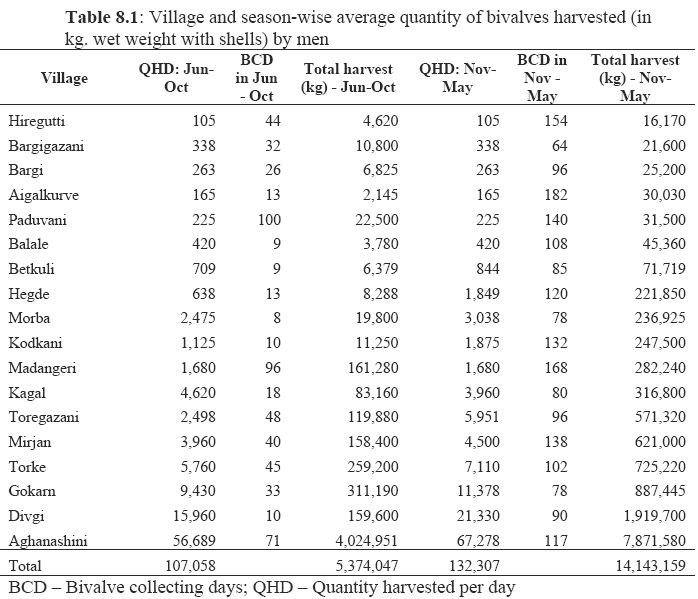
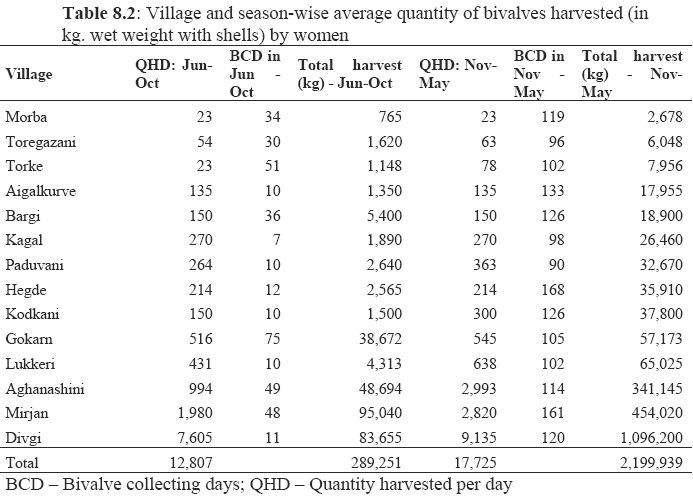
Spot purchases of bivalves harvested are made by traders (Figure 11.1) who transport
them to nearby towns and even to neighbouring states, especially to Goa. The local
marketing is usually carried out by the women of fishing communities, who make
household sales in Kumta town and nearby villages. Some female also carry the
bivalves to the local fish markets (Figure 11.2). The harvesters also use small part of
the collection for domestic use. Bivalve harvested in this estuary is estimated at
22,006 t/yr, which generates a total primary annual net income of about Rs. 57.8
million (Rs. 57,018,710 from bivalve collection and Rs. 816,267 from supplementary
products like empty shells and dried meat). Aghanashini village, which accounts for
the highest production of bivalves alone earns about Rs. 33 million (58% of total
income). More details about village, season and gender-wise income per year is given
in Table 9. The average income for the male was Rs. 29,129 from 140 collection days
for the study year 2006-07, whereas it was Rs. 10,497 for the female from 147
collection days. Some quantity of bivalves collected is used for the production of
dried meat, which earns marginally more profit than sale of fresh bivalves. The
estimated annual income from the sale of empty shells is Rs. 483,850 (Table 10) and
from dried bivalve meat is Rs. 334,983 (Table 11).
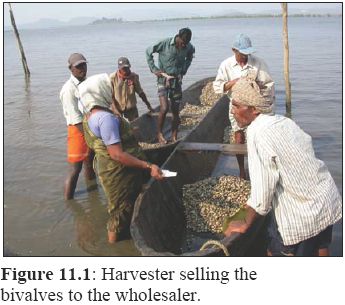
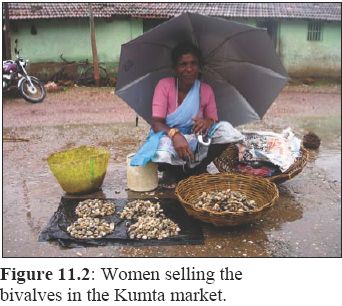



Parts of the estuary are leased out for the mining of empty shells, which are used by
various industries for the production of poultry-feed, lime, fertilisers, etc. The annual
production of shells is around 80, 000 to 100,000 t and the market price ranges from
Rs. 750 to 950/t. About 600 persons (only men, especially those operating native
boats) are engaged in shell mining (Figure 12.1) in addition to transporters - about
200 persons (Figure 12.2). As shell mining depends largely on the deposits of dead
shells, in the long run it is not going to be sustainable. Sustainable harvest has to be
limited to procurement of shells of live bivalves and annual deposits of dead shells of
unexploited bivalves which needs further investigation. The gross annual value of the
shells is about Rs. 76.5 million.
Dried Meat
Clams are used in the drying process. In general, locally collected sticks, woods or
purchased wood is used for boil the vessel contain bivalves and freshwater. The
boiling process may take about half to one and half hour or more that depends on the
quantity involved in the boiling process. Then their shells are removed and flesh sundried
for two days. The dried bivalves (Figure 13) can be kept for years for human
consumption. The cost of one kolaga (approximately 1 to 1.25 kg) of dried bivalves
will be Rs. 80 to 200 that depend on the season and demand.
Valuation of estuary based only on bivalve production
The annual harvest of bivalves in Aghanashini estuary is estimated to be 22,006 t
(edible portion (Figure 14) about 9% of fresh weight). On an average an individual
consumes 50 g of meat for about 200 days a year. Therefore the bivalves of this
estuary alone contribute substantially towards protein and mineral rich nutrition of
about 198,000 people of the west coast.

About 186 ha of the estuary, estimated to be used for bivalve harvesting (Figure 15).
Therefore the average annual income per year for every hectare of bivalve harvesting
area can be put at Rs. 306,552. It is an amazing yield/ha compared to any other
natural ecosystem or agricultural systems, and that too this yield is without input of
any kind into the system by humans. Majority of the 105 harvesters whom we
interviewed opined that over the years, despite the harvests, there has been hardly any
change in the availability of bivalves. However, a small number of harvesters
expressed that there has been a declining trend in recent years. It is learnt that during
2007 – 08 period overharvesting due to rising demand from Goa has created local
scarcity and spiraling of bivalve prices.

Shell mining is done in an area of 100 ha per year out of a total lease area of 809.37
ha (20 years lease period). The shells mined at prevailing market prices are worth Rs.
765,000/ha/yr. Hence, the total value of the estuary based on live bivalve and shell
production is worth Rs. 1,071,552/ha/yr. This demonstrates the high productive
potential of the estuary compared to any other economic sectors. This valuation does
not include other goods that the estuary provides such as production of shrimps, fish,
crabs, salt, mangroves, etc. in addition to services such as fish spawning grounds,
nutrient cycling, hydrology, flood control, soil protection, sink for carbon, etc.
Estuaries are ranked among the highest productive natural ecosystems of the world.
Based on all goods and services that estuaries provide Costanza et al. (1997)
estimated the value of an estuary as USD 22,832/ha/yr. The west coast of India is
dotted with the estuaries of numerous rivers which originate in the Western Ghats,
one of the global biodiversity hotspots. Yet there has been an almost callous neglect
and misuse of these high ranking productive ecosystems causing inestimable losses.
Conclusion
Unplanned developmental activities based on ad-hoc approaches in planning in recent
decades have telling effects on the Aghanashini estuary. In the early 1970’s about
728.44 ha of productive estuarine ecosystem areas were leased for industrial salt
production and subsequently abandoned due to failure of the project. Thereafter in a
frenzied drive to promote shrimp production for export substantial portion of the
estuary was put to intensive shrimp farming, destroying much of the mangroves as
well as the traditional salt tolerant Kagga rice fields. There has also been a sharp
decline in the rich bird and fish fauna following these perturbations. The most recent
threat to the estuary has been from the proposed Ultra Mega Power Plant. However,
this project has been shelved due to protests from the ecosystem people whose
livelihoods were to be imperiled by such an establishment and also from
environmentalists. The study underscores the need for greater sensitivity and vision
on the part of planners and decision makers towards conservation and sustainable
management of pristine and productive ecosystems, particularly of Western Ghats
west coast region. This study is an initial attempt to evaluate some important aspects
of estuarine goods, which has a major role in livelihood aspects of ecosystem people.
However, valuation of the estuary services and goods of an estuary requires further
investigations for a comprehensive understanding of various components.
Acknowledgements
We are grateful to Dr Prakash Mesta, Dr Nayak, V N, and Dr Kusuma Neelakantan,
Dept. of Marine Biology, Karwar for the help extended in the identification of
bivalves and valuable suggestions. Ravish, helped in the fieldwork. We thank the
villagers for their co-operation during survey. We thank the Ministry of Environment
and Forests, Government of India for the financial assistance.
- Apte, D. 1998. The Book of Indian Shells. Bombay Natural History Society, Oxford
University Press, Mumbai.
- Babu, K.K.S. and Nayar, C.K.G. 2004. A new species of the blind fish HoraglanisMenon (Siluroifea: Claridae) from Parappukara (Trichur District) and a new report of
Horaglanis krishnai Menon from Ettumanur (Kottayam district), Kerala. JBNHS,
Vol. 101 (2): 296 – 299.
- Bhat, A. 2003. Diversity and composition of freshwater fishes in four river systems of
Central Western Ghats, India. Environmental Biology of Fishes. 68:25-38.
- Bhat, P. K. 2003. Hydrological Studies of Aghanashini Estuary, Kumta - Central
West Coast of India. Ph. D Thesis. Karnataka University, Dharwad.
- Chatterji, A., Z. A. Ansari, B. S. Ingole, M. A. Bichurina, M. Sovetova and Y. A.
Boikov. 2002. Indian marine bivalves: Potential source of antiviral drugs. Current
Science, 82: 1279-1282.
- Costanza, R., R. d'Arge, R. deGroot, S. Farber, M. Grasso, B. Hannon, K. Limburg,
S. Naeem, R.V. O'Neill, J. Paruelo, R.G. Raskin, P. Sutton and M. van den Belt.1997. The valuation of the world’s ecosystem services and natural capital. Nature,
387: 253-260.
- CSIR. 1962a. The Wealth of India: Raw Materials Vol. VI: L-M. National Institute of
Science Communication and Information Resources, CSIR, New Delhi, India.
- CSIR. 1962b. The Wealth of India: Raw Materials Vol. IV Supplement - Fish and
Fisheries. National Institute of Science Communication and Information Resources,
CSIR, New Delhi, India.
- Dahanukar, N., Raut, R. and Bhat, A.2004. Distribution, endemism and threat status
of freshwater fishes in the Western Ghats of India. Journal of Biogeography. 31:123-
136.
- Daniels, R.J.R. 2003. Biodiversity of the Western Ghats: An overview. In ENVIS
Bulletin: Wildlife and Protected Areas, Conservation of Rainforests in India, A.K.
Gupta, Ajith Kumar and V Ramakantha (editors), Vol. 4, No. 1, 25 – 40.
- ftp://ftp.fao.org/docrep/fao/009/y4160e/y4160e04.pdf (Accessed on November 08,
2008).
- Ghosh, A.K. 1992. Estuarine Ecosystem in India and Faunal Resources. Estuarine
Ecosystem series No (1) Rushikulya estuary. Zoological Survey of India, 1-5.
- Gosling, E. 2003. Bivalve molluscs –Biology, Ecology and Culture. Blackwell,
United Kingdom.
- Gururaja, K.V. 2004. Sahyadi Mandooka: Western Ghats Amphibians, Sahyadri enews:
http://wgbis.ces.iisc.ac.in/biodiversity/newsletter/issue6/index.htm.
- http://india.gov.in/sectors/defence2.php (Accessed on January 04, 2007).
- http://www.biodiversityhotspots.org/xp/hotspots/hotspotsscience/key_findings/Pages/
default.aspx (Accessed on November 08, 2008)
- http://www.cmfri.com/html/cmfriDATA01.html (accessed on July 25, 2008).
- http://www.cmfri.com/html/cmfriDATA01.html (accessed on July 25, 2008).
- http://www.karnataka.com/profile/physiography.html (Accessed on December 21,
2007)
- http://zpkarwar.kar.nic.in/CensusAnkolaVWP.htm (accessed on July 21, 2008).
- James, P.S.B.R., S.L. Shanbhogue and T.R.C. Chandrasekhara Gupta. 1975.
Estuarine fisheries resources of South Kanara District, Karnataka. In: Recent
Researches in Estuarine Biology. (ed. Natarajan, R). pp. 99 – 104. Hindustan
Publishing Corporation, Delhi, India.
- Mane U. H. 1973. Studies on the Biology, Ecology and Physiology of the Marine
Clams. Ph.D Thesis. University of Bombay, India.
- Nagabhushanam, R. and Thompson M. 1997. Fouling Organisms of the Indian
Ocean: Biology and Control Technology. CRC Press.
- Pritchard, D. W., 1967. Observations of circulation in coastal plain estuaries. In:
Estuaries. Ed. G.H. Lauff. Am. Ass. Adv. Sci., 83: 37-44.
- Ranade. 1964. Studies on the Biology, Ecology and Physiology of the Marine Clams.
Ph.D Thesis. University of Bombay, India.
- Roberts, D. 1999. Commercial exploitation of bivalves. International meeting on
Biology and Evolution of the Bivalvia, Malacological Society, London.
- Staples D., Satia, B. and Gardiner, P.R. 2004. A research agenda for small-scale
fisheries. Food and Agriculture Organization of the United Nations Regional Office
for Asia and the Pacific, Bangkok.
- Venkataraman, K. and Wafar, M. (2005) Coastal and marine biodiversity of India.
Indian J. Mar. Sci., 34 (1): 57-75.
- Volman, T. P. 1978. Early Arche
ological Evidence for Shellfish Collecting. Science,
201: 911-913.
- Winkler, R. 2006. Valuation of ecosystem goods and services Part 1: An integrated
dynamic approach. Ecological Economics, 59: 82-93.
